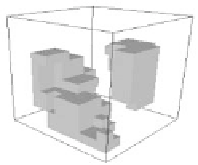Biomedical Engineering Reference
In-Depth Information
TABLE 5.1
Biological Recognition Elements that Are Commonly Used in Biosensor Designs
Biological Element
Mechanism for Recognition
Antibodies and antigens
Based on the specific and high-affinity antibody-antigen binding interactions.
Tracers such as fluorescent molecules, enzymes, and radioisotopes are used
to generate a detectable signal.
Biomimetric receptors
Genetically engineered molecules such as single-chain antibody fragments.
RNA and DNA aptamers.
Artificial membranes.
Enzymes
Catalytic transformation of an analyte to induce a signal or generate a
product that can be detected by the transducer.
Monitoring enzyme characteristics that change upon direct interaction
with the analyte.
Nonenzymatic proteins
Class of proteins that contain one or more selective binding sites and produce
a signal through a transmembrane ion channel or a secondary messenger
enzyme activation system.
Nucleic acids
Detection of DNA-ligand interactions (e.g., monitoring pollutants).
Detection of specific DNA sequences by hybridization.
Whole cells
A substance-dependent increase or inhibition of microorganism respiration
(e.g., changes in bacteria and fungi respiration to pollutants).
Feature
extraction
Sensor
x
1
x
1
x
1
1
x
2
x
2
x
2
2
3
Sample
x
3
x
3
x
3
3D SOFM
Matched features
displayed in 3D space
FIGURE 5.10
Feature associate determined using a 3D SOFM. At each instant in time, the three biosensors generate a triplet
(
x
1
,
x
2
,
x
3
).
relationships between the classes. The SOFM lattice not only influences how data is reor-
ganized during weight adaptation but also provides a mechanism for displaying the
desired relationships between the numeric data vectors that have been mapped onto the
SOFM space.

















